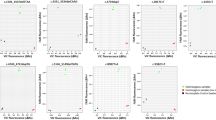Summary
The whole length of exon 11 of BRCA1 was sequenced (total 3427 bp) in 59 patients and 10 healthy female blood donors. To allow a rapid determination of the different BRCA1 alleles, a sequence-specific primer PCR method (PCR-SSP) was established and was applied to 57 additional female donors. Finally, the full-length coding region of BRCA1 was analyzed through reversed-transcriptase PCR (RT-PCR) and cDNA sequencing (total 5554 bp) in one donor with wild-type allele and 2 patients with one or two matated alleles. By genomic DNA sequencing, 5 homozygous polymorphisms were observed in 18 patients: 2201C>T, 2430T>C, 2731C>T, 3232A>G and 3667A>G All of them were previously observed in Caucasians, Malay and Chinese, but for the first time the mutations were found in one allele (GenBank AY304547). Twenty-six patients and 4 donors were heterozygous at these 5 nucleotide positions. The remaining 15 patients and 6 donors showed a sequence identical with the standard BRCA1 gene. Combined the PCR-SSP results and in a summary, 6 of 67 (9.0 %) healthy individuals were homozygous for the mutated allele, whereas 18 of 59 (30.5 %) breast cancer patients were homozygous. A Chi-square test showed a significant correlation between homozygous mutated BRCA1 allele and breast cancer. The cDNA sequencing showed that 2 additional mutations, 4427T>C in exon 13 and 4956A>G in exon 16, were found. A new BRCA1 allele, which is BRCA1-2201T/2430C/2731T/3232G/3667G/4427C/4956G (GenBank AY751490), was found in Chinese. And the homozygote of this mutated allele may implicate a disease-association in Chinese.
Similar content being viewed by others
References
Fodor F H, Weston A, Bleiweiss I J et al. Frequency and carrier risk associated with common BRCA1 and BRCA2 mutations in Ashkenazi Jewish breast cancer patients. Am J Hum Genet, 1998,63:45–51
Ford D, Easton D F, Stratton M et al. Genetic heterogeneity and penetrance analysis of the BRCA1 and BRCA2 genes in breast cancer families. The Breast Cancer Linkage Consortium. Am J Hum Genet, 1998,62:676–689
Ke Y, Wang X, Feng M et al. Analysis of mutation sites of BRCA1 gene in Chinese patients with breast cancer. Chin J med Genet (Chinese), 2002,19:383–385
Khoo U S, Ngan H Y, Cheung A N et al. Mutational analysis of BRCA1 and BRCA2 genes in Chinese ovarian cancer identifies 6 novel germline mutations. Hum Mutat, 2000,16:88–89
Khoo U S, Chan K Y, Cheung A N et al. Recurrent BRCA1 and BRCA2 germline mutations in ovarian cancer: a founder mutation of BRCA1 identified in the Chinese population. Hum Mutat, 2002,19:307–308
Sng J H, Chang J, Feroze F et al. The prevalence of BRCA1 mutations in Chinese patients with early onset breast cancer and affected relatives. Br J Cancer, 2000,82:538–542
Tang N L, Pang C P, Yeo W et al. Prevalence of mutations in the BRCA1 gene among Chinese patients with breast cancer. J Natl Cancer Inst, 1999,91:882–885
Zhen L, Wu Z, Fan P et al. Mutation analysis in breast cancer susceptibility gene-1 in 23 Chinese familial breast cancer patients. Acta Universitatis Medicinalis Nanjing (Natural Science) (Chinese), 2002,22:191–193
Zhi X, Szabo C, Chopin S et al. BRCA1 and BRCA2 sequence variants in Chinese breast cancer families. Hum Mutat, 2002,20:474–479
Steinmann D, Bremer M, Rades D et al. Mutations of the BRCA1 and BRCA2 genes in patients with bilateral breast cancer. Br J Cancer, 2001,85:850–858
Shao C P, Maas J H, Su Y Q et al. Molecular background of Rh D-positive, D-negative, Del and weak D phenotypes in Chinese population. Vox Sang, 2002,83(2):156–161
Dunning A M, Chiano M, Smith N R et al. Common BRCA1 variants and susceptibility to breast and ovarian cancer in the general population. Hum Mol Genet, 1997,6:285–289
Han W, Kang D, Park I A et al. Associations between breast cancer susceptibility gene polymorphisms and clinicopathological features. Clin Cancer Res, 2004,10:124–130
Osorio A, de la Hoya M, Rodriguez-Lopez R et al. Over-representation of two specific haplotypes among chromosomes harboring BRCA1 mutations. Eur J Hum Genet, 2003,11:489–492
Author information
Authors and Affiliations
Additional information
This project was supported by a grant from Governmental Scientific Research Program of Shenzhen (No. 200304283).
Rights and permissions
About this article
Cite this article
Zhou, D., Xiong, W., Xu, H. et al. A novel frequent BRCA1 allele in Chinese patients with breast cancer. J. Huazhong Univ. Sc. Technol. 26, 576–579 (2006). https://doi.org/10.1007/s11596-006-0525-4
Received:
Issue Date:
DOI: https://doi.org/10.1007/s11596-006-0525-4



